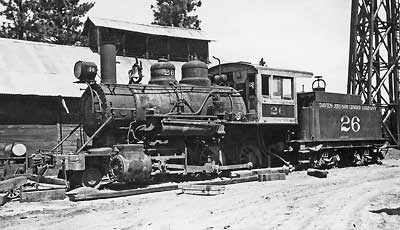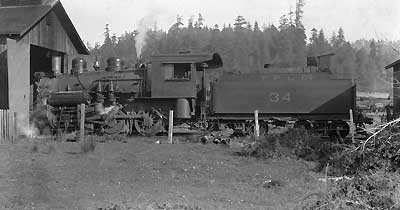|
We're writing from memory here, because our valued copy of Jack Wagner's The Last Whistle is under wraps in 2400 miles away in a warehouse shared by Wx4 with a distributor of glass eyes. It would be best to consider the following as akin to one of those movies that was "inspired (them: with the help of serious pharmaceuticals; us: Bourbon) by actual events".
What we recall of Ocean Shore Railway was that its north end (which never managed to connect with the south end due to insufficient funds borne of insufficient traffic) was by and large a functionary operation governed by real estate promotional efforts to sell plots of fog under which land was thought to exist. In this regard, the year 1916 must have been so good for sales that real estate agents felt compelled to lean on Ocean Shore management to run trains of larger capacity, say 3500 clients all at one whack, rather than 350. This OSRR could not do with even its most modern locomotive, a 1915 2-6-0 of modest dimensions, so otherwise they were talking double, or triple heading.
Thus, employing traditional railroad accounting logic, the company went shopping (or maybe sent the real estate guys shopping) for locomotives that would fit the bill. Those costly extra engine crews could be eliminated in favor of an enormously expensive locomotive, which could be expected to be utilized at least seven (this is a charitable estimate) times a year. This was called spending a dollar to save a dime, a grand railway tradition
Anyway, it must have been like salivating over pralines at a candy shop, or ogling at the Sears Christmas catalog toy train set lineup for the lucky guy assigned to peruse the Baldwin catalog for a beast to match his superiors' feelings of motive power inadequacy. But, well heck, a 2-8-2 surely would have been to anemic for the task, and a 2-10-2 probably would have spent a good deal of time laying on its side next to a tight curve, whose rail was probably purloined 12 pounders from a local farmer's fruit dehydrator. An articulated locomotive seemed the perfect answer, not only because it might be better equipped to handle serpentine rail, but also because it would be macho big. Thus, OSRR's purchasing agent - who given the railroad's size, probably doubled as a grease monkey most of the time - put in a quote request for a 2-6-6-0 similar to the impressive one that he recently had ridden behind on a recent Moffat Road daisy picking excursion. Apparently his bosses did not judge the loco to be sufficiently manly to make up for their railroad's shortcomings, so a few days later, another request went off to Baldwin for a grander piece of locomotion, a mighty 2-8-8-0! It appears that awhile later they realized that their outfit did not possess sufficient cars to fill out the train that the loco conceivably was capable of hauling, and even if said additional equipment could be located, the train would stretch halfway across the railroad, meaning that those real estate agents at Granada, or Xanadu, or whatever its name was, would have been sorely pissed when the train reached its final destination, only to find that the distant rear car had stopped in Daily City, causing their prospective customers to buy bargain basement land there, thinking it was Granada at a discount. (note: Daly City frequently gets socked in with fog, as well.) Sadly, neither loco made it into the Baldwin order book. This and other similarly cloudy thinking caused the railroad to fold four years later.
New 8-2022:
We ran across the article at right while researching our epic Armona passenger trains story. It seems that the Ocean Shore's luminaries had trouble holding their liquor, but come to think of it, maybe the articulateds represented a revival of the plan during a later extended drunk.
|
 |



